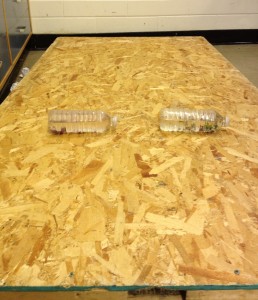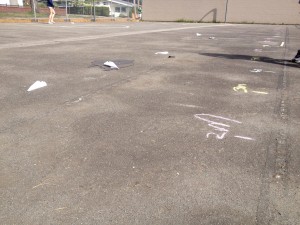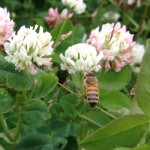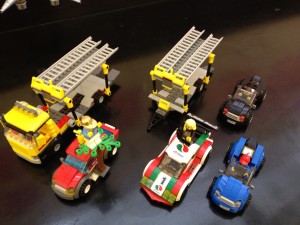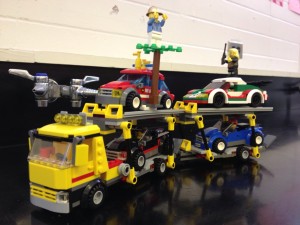In order to demonstrate viscosity, I did a demonstration with a bottle of water rolling beside a bottle of corn syrup. The students were very engaged in discussing the different properties of water and corn syrup and how they interacted with the bottle. I actually was not sure how this lesson would go over, but I was really impressed with the students’ responses. To relate it to my belief statements, I think it really makes a difference to simply change the physical set up of the class and let them move around and sit differently in different situations. I changed the dynamic of the class and led to more discussion to have a more relaxed physical setup for the demonstration.
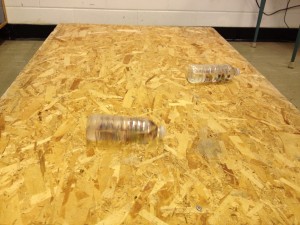
Category Archives: Photos
Connecting Learning to Practice – Paper Airplanes
Another idea pulled from our science class at UBC was using paper airplanes. In this case I used it to get the class outside and make a lesson on graphing and data collection a little more exciting. I did struggle a little with structure and would try to organize the actual throwing and measuring of the planes better if I did it again. I would probably just have the students in partners instead of larger groups as I did on this day.
Connecting Learning to Practice – Tinfoil Boats
Gallery

This gallery contains 7 photos.
We had a fantastic class on pedagogy in science and I found it very valuable when I was actually teaching. In this case, I used an activity that we learned in our class at UBC to teach a lesson on buoyancy. … Continue reading
Quotes
Gallery
Community Field Experience
During my community field experience, I had the opportunity to visit two situations. The first was at a middle school helping with a program specialized for students how are years behind in reading and writing as well as helping the students services teacher. This was a phenomenal experience. The specialized program, the teaching and evaluation center, was amazing to experience. Seeing the students enjoying reading and working so hard as well as seeing the relationship the had built up with the teacher was amazing. I also gained an entirely new perspective on students in my class that may be struggling and appearing to not care. Often, we facilitate their lack of interest and care by having low expectations for them. In the afternoons we helped with the students services or special education teacher. In particular, there were two students with autism that required extra help and it was so great to get to know them and work with them. I wish I was able to have more time to work with them.
My final two weeks were spent at a local daycare providing programs for stduents during the strike. It was interesting to see a different perspective of the program as a teacher. It was difficult to adjust to the lack of schedule and try to just fill time without specific aims and goals. We did spend a lot of time outside and I thought about how I could continue to incorporate more time outside into my lessons. Below are some pictures from one of our nature walks and the wild life that I discovered and discussed with the students.
- Spending time outside can be a game changer, especially if you can be prepared to come up with a lesson about what you see.
- Water bugs
- Slug climbing up a rock.
Practicum – Week 1
Highlights – teaching body systems with Lego and diffusion with water and food coloring.
I started my first week off with a bang. As any new, keen student teacher would, I planned a number of activities and found there was not enough time for most of them. Many of them ended up rushed. Day one I took the students outside to talk about body systems. I had the students run around the track and then discussed what was happening in their body. I learned how long it can take a 13 year old to get around a track and so for the next class I simply had them run to the end of the school and back.
My next hands on science lab was to deal with the increasing complexity of how the human body is made. Cells come together to make tissues, tissues form organs and organs for organ systems. To demonstrate this, I had the students build with Lego. The class was split into 6 groups. Each group were given a specific structure to build. One group built the cab of a car transporter, another the back and trailer. Four groups each built a different car. We then came together and discussed how cells are like each Lego piece. Cells are small and specialized to fill a particular role and each Lego piece is as well. These smaller pieces come together to make a larger structure. We then compared how those structures fit together to make a larger organism by comparing the cab to the brain, the trailer to the skeletal and muscular system and then each car to a different internal system e.g. digestive system, respiratory system, etc.
In addition, this week I also taught a lesson on diffusion and osmosis. As this is such an important process in your body, I really wanted the students to understand it and how passive it is. It is amazing that we really so much on such a simply process for our very life. Each students observed how food coloring spreads out in a cup of water and then observed how a teabag works in order to observe osmosis. The students seemed to enjoy the opportunity to see what was happening and not just hear about what happens your body.
Over all it was a great first week.

